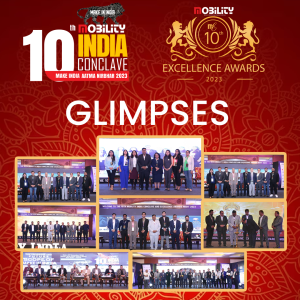Smart TVs have evolved from mere televisions to multimedia hubs, offering seamless access to streaming services, online content, gaming, and even smart home integration as technology continues to evolve. The present scenario for televisions and especially for home-grown, tech-focused affordable TV brands is promising.
Mobility Magazine has taken inputs from various industry leaders and done an in-depth study on the industry trends and the factors that have attributed to the growth of the smart TV segment in India and take us through the anticipated way forward. This article has clear insights from industry veterans who share their opinion on the opportunities, brand positioning, and the future roadmap.
Industry Insights
- Global Perspective
The global smart TV market size is expected to be valued at USD 451.26 billion by 2030, at a compound annual growth rate (CAGR) of 11.4% from 2023 to 2030. The rise in use of OTT applications and services for streaming latest TV content on smart televisions because of wide availability of high-speed internet such as 4G, broadband internet, and 5G, is driving the viewing experience for users globally, driving the market growth.
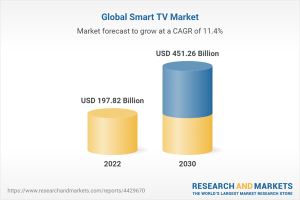
- India Perspective
India’s smart TV shipments grew 28% YoY in 2022 and the growth for the year was primarily driven by strong shipments during the festive season in the third quarter, multiple new launches, discounts and promotions, and the demand for bigger screen-size TVs in the lower price tier. For Q4 2022, the growth was almost flat at 2% YoY due to a slowdown in demand after the festive season. (Counterpoint Research)

Commenting on the market trends, Research Analyst Akash Jatwala said, “Consumers are preferring bigger screen sizes, especially 43”, due to which the smart TV shipments in this display size grew 29% YoY in 2022. This size has also started trickling down to the budget price range (INR 20,000-INR 30,000 or ~$243-$364). Dolby integration is another most sought-after feature and is available in lower-price TVs too. Dolby Audio support in the INR 10,000-INR 20,000 (~$121-$243) price band increased 37% YoY and was available in about 41% of the smart TVs shipped in 2022. On the operating system side, Google TV grew multifold and was available in 4% of the smart TVs shipped during the year. Many brands are launching TVs with Google TV in the mid-segment (INR 30,000 – INR 50,000). In terms of country of origin, Indian brands showed the fastest growth and had a share of 24% in smart TV shipments during the year, whereas global and Chinese brands had 40% and 36% shares respectively.”

Looking at the market growth, Senior Research Analyst Anshika Jain said, “OnePlus, Vu, and TCL were among the fastest-growing brands in the smart TV segment in 2022. Xiaomi led the overall smart TV market with an 11% share, followed by Samsung and LG. Smart TV shipments in the INR 20,000-INR 30,000 price band grew 40% YoY to reach a 29% share. The average selling price (ASP) declined 8% YoY to around INR 30,650.”
Jain added, “Smart TV contribution to overall shipments reached its highest ever of 90% during the year. It is expected to go up further due to more launches in the sub-INR 20,000 price range and non-smart-TV-to-smart-TV migration. Non-smart TV shipments declined 24% YoY in 2022. Online channels increased their contribution to the total shipments to 33% during the year.”
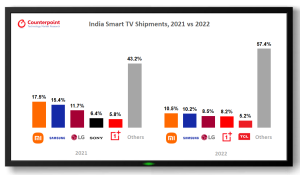
- Market summary for Q4 2022
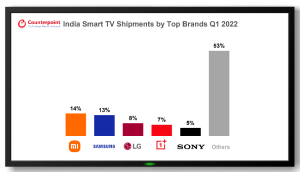
- TV Shipments Comparative Study 2021-2022
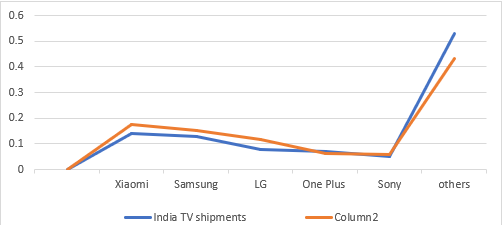
- Factors that Triggered growth
Smart TVs are like smartphones as they have an operating system and offer streaming services via an internet connection. In addition, these TVs enable users to engage with services such as downloading apps, playing video games, and accessing social media sites, among other things. The Indian consumer is actively moving toward such products owing to increased admiration for OTT streaming services and the affordability of high-speed internet access across the country. Furthermore, the government’s emphasis on Digital India and the ongoing Make in India initiative has become important growth driver.
- Screen Size Insights
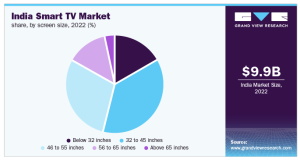
The 32 to 45 inches segment dominated the market in 2022 with a revenue share of over 37.0%. The increased adoption of smart TVs drives the growth of this segment with medium screen sizes and the integration of 4K technology in such TVs. Moreover, the market players in India are introducing smart TVs with a screen size of 32 to 45 inches at competitive prices to attract the middle- and lower-income group population.
- India Smart TV Market Segmentation
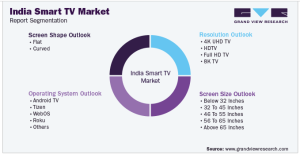
INDUSTRY VETERANS Share Opinion
Mobility Magazine has done an in-depth study with the industry leaders in Smart TV and culled out the relevant information about the reason for the burgeoning rise of Smart TVs, the market trends, and market strategies adopted by the brands in order to give the best cinematic experience to the consumers at the most affordable costs.
Shift in Smart TVs
Key factors that are driving the Indian smart TV market growth include an increase in the usage of streaming devices and the internet and the rising popularity of newer TV resolutions in 4K, UHD, and 8K across the country.

Mr. Avneet Singh Marwah, Director and CEO, Super Plastronics Pvt Ltd, a Kodak brand Licensee, says, “The major reason behind the shift from CRT is the ecosystem that Android has created in India. Brands like Samsung, Sony, and LG used to hold 97% or 87% of the market share don’t even hold 20% of the share now. So, there has been a drastic change in the ecosystem. Due to affordability, we have made our products very pocket friendly. There are 300 million Android customers which has surely helped. The ecosystem is better in India, and people understand it better than in the US. Market trends change rapidly, so the market share of WebOS went down.”
“The shift among consumers from CRT TVs to Smart TVs is primarily driven by several factors. Firstly, advancements in technology have made Smart TVs more appealing with their high-resolution displays, improved picture quality, and enhanced audio capabilities. The availability of Internet connectivity on Smart TVs allows users to access a wide range of online content and streaming services. Smart TVs also provide an extensive app ecosystem, offering access to popular applications such as streaming platforms, games, and social media. Smart TVs can seamlessly integrate with other devices such as smartphones, tablets, and home automation systems, providing a connected and convenient user experience. The rise in OTT platforms and streaming services has further increased the demand for Smart TVs. In a nutshell, the user-friendly interface and features of Smart TVs make them an attractive choice for consumers, “says Mr. Pawan Kumar, CEO, Elista.

“It’s the transformation in technology and affordability of Smart TVs today along with availability of content on several streaming Apps. All popular content is now being made available on Apps like Netflix prime video hotstar etc. so people have now moved or started moving to smart TVs,” talks about the shift, Mr. Arjun Bajaj, Director of Videotex International.
Mr. Ranvijay Singh, Head of BRAVIA Business at Sony India elucidates, “The shift among Indian consumers from CRT TVs to Smart TVs can be attributed to several reasons. The advent of Smart TVs has brought about a technological revolution, offering an array of advanced features and functionalities that greatly enhance the overall viewing experience. With Smart TVs, consumers can access a variety of online streaming platforms, browse the internet and enjoy interactive content, all from the comfort of their living rooms. Additionally, the availability of affordable internet connections and the proliferation of smartphones have created a growing demand for Smart TVs that can seamlessly integrate with other devices, making them an attractive choice for Indian households. Furthermore, the convenience factor cannot be overlooked. Smart TVs eliminate the need for additional devices such as set-top boxes or streaming devices, simplifying the home entertainment setup. The user-friendly interfaces and intuitive controls of Smart TVs have made them popular among consumers who seek a hassle-free and streamlined entertainment experience.”
“With digitisation, the Indian market has changed enormously. The telecom penetration has fuelled OTT, digitisation, and initiatives have also been taken by the government of India. India is one of the biggest markets for data. Many factors have helped the Indian market to evolve. The market stability is huge in terms of consumption in India,” says Mr. Atul Jasra Country Head – India – Philips Audio.
Ms Pallavi, Super Plastronics Private Limited says, “A shift is being seen towards bigger sizes in Smart TVs and with consumers preferring 4K TVs over full HD ones, this is bound to happen. OTT content is a major factor while purchasing smart TVs, and with the infinite apps available, it is a deal maker.”
OPPORTUNITIES

Mr. Ranvijay Singh, Head of BRAVIA Business at Sony India says, “In the rapidly growing Indian Smart TV market, Sony BRAVIA has a unique opportunity to tap into the increasing demand for advanced home entertainment systems. To capitalize on this segment, we must focus on key strategies. Firstly, product innovation is crucial. By continuously developing cutting-edge technologies, such as high-resolution displays, HDR support, and immersive audio systems, Sony BRAVIA can offer consumers a superior viewing experience. By understanding the specific preferences and needs of Indian consumers, we can tailor our products to cater to their unique requirements. Secondly, establishing strong partnerships with content providers is essential. Collaborating with popular streaming platforms and local content creators can ensure a diverse and engaging content library, appealing to the diverse tastes of Indian consumers. Additionally, integrating voice recognition and AI-powered features into our Smart TVs can enhance user experience and provide seamless access to content. Furthermore, an effective marketing strategy is vital for capturing market share. By leveraging digital platforms, social media, and targeted advertising, we also reach out to potential customers and showcase the benefits of our Smart TV range. Also, by engaging with consumers through interactive campaigns and promotional offers we help create brand loyalty and increase market penetration. Regarding the market size, the Indian Smart TV market has witnessed significant growth in recent years, driven by factors such as rising disposable incomes, increasing internet penetration, and changing consumer preferences. This presents a substantial opportunity for our brand to capture a significant share of the market and establish itself as a leading player in the Indian Smart TV segment.”
Mr. Avneet Singh Marwah, Director and CEO, Super Plastronics Pvt Ltd, a Kodak brand Licensee says, “The opportunities are huge for us, as we have known the market and consumers over the past 30 years. We have technology partners like Google who sell in and out. We have the exclusive partner Flipkart online, and we are trending in the top 2 and top 3 in the last 4 quarters.”
“As the second-largest TV manufacturer in the country, we recently announced a 100-crore investment in a new plant with a manufacturing capacity of over 2 million units. The Indian government’s support in enabling local chipset manufacturing presents a tremendous opportunity for us. This initiative allows us to reduce the outsourcing of 70% of crucial components, resulting in significant cost savings and increased efficiency, “explains Ms. Pallavi Westinghouse.
Mr. Pawan Kumar, CEO, Elista expresses his opinion, “Several strategies are used to tap the opportunities in the Smart TV segment. Conducting thorough market research is essential to identify consumer preferences, market trends, and potential demand. The insights help in developing products that meet the needs of the target audience. Forming content partnerships with popular streaming platforms and OTT providers also help to enhance the content offerings on Smart TVs, making them more appealing to consumers. Additionally, focusing on product differentiation by offering unique features, superior build quality, and innovative designs can help establish a competitive edge. Educating the channel network about the benefits and features of Smart TVs is crucial to drive sales and ensure effective distribution.”
Mr. Arjun Bajaj, Director of Videotex International. expresses, “We being an ODM for last 39 years have ensured to provide the best TV solutions to our customers/brands associated with us and we are known to provide the best solutions in the Industry and stay ahead of the curve. We regularly study the market and take feedback from our customers to understand the need and requirement and make products for the future.”
Positioning of Brands
Brands are vying and trying to compete ahead of the rising curve. Brands are constantly attracting clients by developing affordable products and setting competitive prices for customers.

Discussing about the brand, Mr. Atul Jasra Country Head – India – Philips Audio says, “Our professional displays are mostly B2B where we have a very good product line with minimum downtime. We offer excellent after-sales service which is of international standard. We also launched an interactive tunnel in the professional display segment in India three months back which has received very good feedback. We are competing well with other renowned brands in the market.”
Speaking about the brand positioning, Mr. Arjun Bajaj, Director of Videotex International says, “ Our USP lies in our infrastructure, the quality, the services that we provide, our R&D and our experience and Innovations. These are the USPs for which are known in the industry and the reason why brands choose us. We have positioned ourselves as being the first ODM for webOS in India and building a market for it from scratch to now being the global strategic partner of webOS says it all.”
Mr. Avneet Singh Marwah says, “We have our own design tools and all hardware in-house. Affordability is another player here. We get a bigger screen size on the same premium brand. We are launching the best premium TVs in the last quarter and working on the best technology TVs. We set ourselves up after sales. We give service to 19000 pin codes, which is not offered by any Indian brand in the market. Furthermore, we have 900 India service centres. We have managed to sell 1 million units.”
“Our commitment to technological excellence is a key USP. Sony BRAVIA Smart TVs are known for their superior picture quality, vibrant colors, and immersive audio systems. We leverage our expertise in display technologies, such as 4K resolution and HDR support, to deliver an unparalleled viewing experience to our customers. Secondly, our focus on content integration is another USP. Sony BRAVIA Smart TVs come with a wide range of pre-installed apps and seamless integration with popular streaming platforms, ensuring a diverse content library at users’ fingertips. We prioritize partnerships with content providers to deliver an extensive selection of local and international content, catering to the diverse preferences of Indian consumers. Additionally, our gaming mode feature is a significant USP that positions Sony BRAVIA as a preferred choice for gaming enthusiasts. By reducing input lag and optimizing the display settings, our Smart TVs provide an immersive and responsive gaming experience, enhancing the enjoyment of console gaming. In the Indian market, we emphasize the exceptional quality and performance of our Smart TVs, showcasing how they elevate the viewing experience to new heights. Through targeted marketing campaigns, engaging with influencers, and highlighting our technological advancements, we position Sony BRAVIA as the premium brand that offers the best-in-class Smart TVs for discerning Indian consumers.” explains Mr. Ranvijay Singh, Head of BRAVIA Business at Sony India.
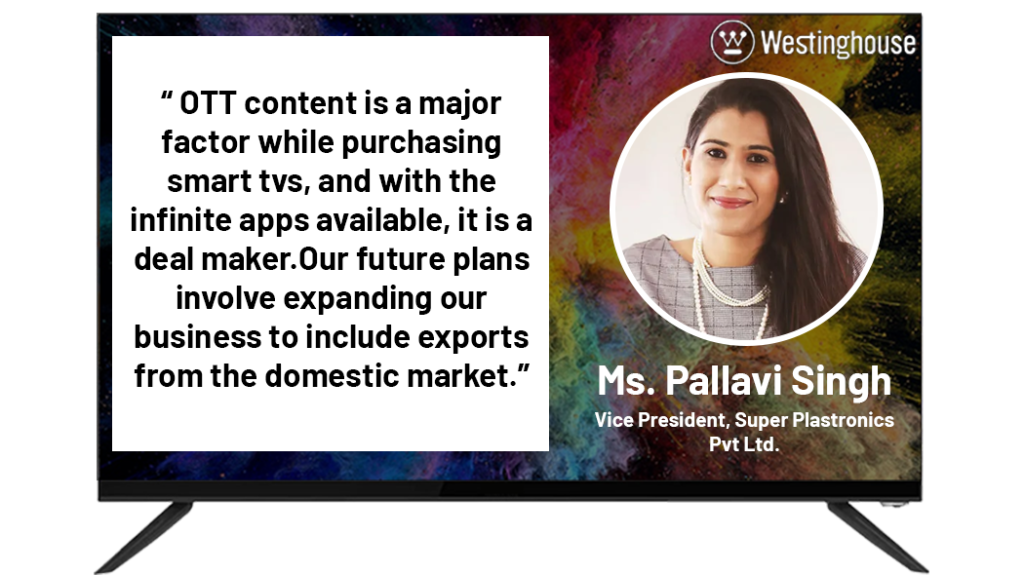
Ms. Pallavi, Westinghouse says, “We are currently focused on becoming market disruptors with our upcoming product launches. While we do have plans in motion, we prefer to keep them under wraps for now. Rest assured, we will keep you informed and share details about our exciting new offerings in the near future.”
“The USP of Elista in the market is affordability with best-in-class features. By offering competitive pricing without compromising on quality, Elista aims to cater to a wide range of consumers, making consumer electronics more accessible. Positioning the brand as “Made in India for the world” emphasizes Elista’s commitment to manufacturing high-quality Smart TVs for both domestic and international markets. This positioning leverages India’s expertise in technology manufacturing and highlights our global aspirations,” explains Mr. Pawan Kumar, CEO, Elista.
Innovations
Most of the brands are definitely producing entry-level to high-end smart TVs, based on features and quality. The high-end smart TVs are produced with high-quality display panels and parts, which significantly increase the product price.
Talking about innovations, Mr Arjun says, “webOS is one of the best solutions we have come across and the product works seamlessly and is so user-friendly that a customer can just get hooked to it within minutes. Innovations reside at the core front at Videotex. Our latest innovation is the QLED TVs being launched in the webOS TVs with DCI-P3 94% making it stand out from other TVs available in the Industry. India as a market surely welcomes Innovation but is very price sensitive.”

Talking on the innovations, Mr. Pawan Kumar, CEO, Elista says, “The market for innovations such as WebOS in India has already shown promising response and traction. WebOS, an operating system for Smart TVs, provides a user-friendly interface and seamless integration with various applications and services. Continued improvements in features, content partnerships, and user experience are being prioritized to further enhance the market position of WebOS. The demand for Smart TVs in India, coupled with the growing popularity of online streaming and digital content, presents significant opportunities for innovations like WebOS.”
Elucidating it, Mr. Ranvijay Singh, Head of BRAVIA Business at Sony India says, “We see innovations like WebOS as a promising and exciting development for the industry. WebOS, with its intuitive and user-friendly interface, has the potential to significantly enhance the Smart TV experience for Indian consumers. WebOS offers a seamless and convenient platform for accessing a wide range of content and services. Its intuitive navigation system and user-friendly design make it easier for consumers to discover and enjoy their favourite movies, shows, and applications. With a focus on simplicity and responsiveness, WebOS ensures a smooth and engaging user experience. In the Indian market, where consumer preferences are evolving rapidly, innovations like WebOS play a crucial role. The growing demand for online streaming platforms and interactive content makes it essential for Smart TVs to have advanced operating systems that can deliver a seamless and immersive viewing experience. Sony BRAVIA recognizes the importance of incorporating such innovations to stay at the forefront of the Indian Smart TV market. By embracing WebOS and leveraging its capabilities, we can offer our customers an enhanced and intuitive Smart TV experience, further solidifying Sony BRAVIA’s position as a leader in the industry.”
“Our focus is on launching best-in-class premium LED Televisions. We launched QLED TVs for the holiday season based on inventory for 45 days which got sold out in 4-5 hours! Before the holiday season, you will see more coming up from our share of brands,” says Mr. Avneet, Kodak.
Ms. Pallavi says, “We are currently focused on becoming market disruptors with our upcoming product launches. While we do have plans in motion, we prefer to keep them under wraps for now. Rest assured, we will keep you informed and share details about our exciting new offerings in the near future.”
Opportunities in Smart TV Manufacturing in India
Mr. Avneet elucidates, “We are shifting to a new plant where we can manufacture more than 2 million units, so this plant will be open in the next 2 quarters. We will be manufactured in India, and it will give a lot of goodness, cost-effectiveness, and focus on exports.”
“As the second-largest TV manufacturer in the country, we recently announced a 100-crore investment in a new plant with a manufacturing capacity of over 2 million units. The Indian government’s support in enabling local chipset manufacturing presents a tremendous opportunity for us. This initiative allows us to reduce the outsourcing of 70% of crucial components, resulting in significant cost savings and increased efficiency,” says Ms. Pallavi Westinghouse.
Mr. Arjun Bajaj says, “The scope of smart tv manufacturing is huge and for the last 39 years Videotex has focused on moving ahead with technology and transformed with every step in the tv industry and will continue to do the same and stay ahead as always. India is a huge market with big potential and right now smart tv is everyone’s need.”
Mr. Pawan goes on to explain, “Smart TV manufacturing in India offers numerous opportunities. India is one of the largest and fastest-growing domestic markets for consumer electronics, including Smart TVs. This presents a significant customer base and potential for growth. Manufacturing Smart TVs in India provides a cost advantage due to the availability of skilled labour and lower production costs compared to some other regions. Additionally, the government’s initiatives to promote local manufacturing, such as the Make in India campaign, further support the growth of the manufacturing sector. Manufacturing Smart TVs in India opens doors for export opportunities, catering to both regional and global markets.”
Future Road Ahead
Mr. Pawan Kumar, CEO, Elista says, “The future plans of the brand include bringing Google certified Smart TVs to the market. Collaborating with Google ensures the integration of popular Google services and provides a trusted ecosystem for users. Additionally, Elista will continue to focus on the WebOS category, aiming for further advancements in features, content partnerships, and user experience. By aligning with global technology leaders and consistently improving product offerings, the brand aims to provide a superior experience to the customers.”
“We will be focusing on penetrating the international markets and expanding domestic markets, “shares his views while talking about the future, Mr. Avneet.
While concluding, Mr. Atul Jasra Country Head – India – Philips Audio says, “As a brand, we will always stay trustworthy and transparent with them in our policies. We will always be performing to the best of our abilities for our customers and partners.”
Ms. Pallavi Westinghouse says, “Our future plans involve expanding our business to include exports from the domestic market. Additionally, we are actively exploring new markets to penetrate and establish a presence in. As we continue to explore these avenues, we aim to further expand our reach and solidify our position in the industry.”
Discussing the future road, Mr. Arjun says, “We have recently launched an entire range of QLED TVs in webOS for the brands starting from 32 inches to 75 inches with DCI-P3 94% which has ultimate and breathtaking picture quality for a QLED TV and are now working on upcoming solutions both premium and low cost which we will reveal soon with a host of exciting and useful features. We are now gearing up and working on new solutions and setting up our new manufacturing with a state-of-the-art facility.”
Conclusion
We feel that as the Smart TV Segment continues to play an important role in the future, it’s quite evident that the technology will evolve and play a crucial role in driving success. In such a scenario, identifying hidden opportunities, enhancing productivity, improving customer satisfaction, and envisioning upcoming changes can have a profound effect on the overall business performance.
If you have an interesting Article / Report/case study to share, please get in touch with us at editors@roymediative.com roy@roymediative.com, 9811346846/9625243429.






